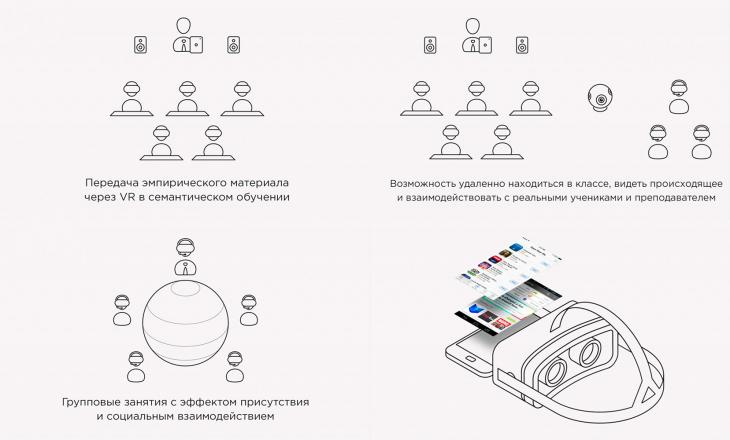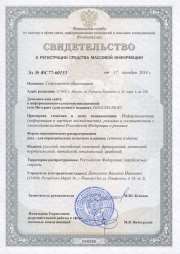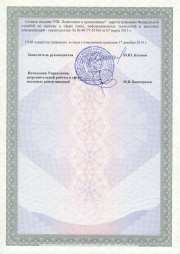|
MAIN PAGE
> Back to contents
Modern Education
Reference:
Loseva-Rimsha N.S.
Substantiation of the use of virtual and augmented reality as a means of developing cognitive interest in children.
// Modern Education.
2022. № 3.
P. 30-33.
DOI: 10.25136/2409-8736.2022.3.35131 EDN: IXOXJZ URL: https://en.nbpublish.com/library_read_article.php?id=35131
Substantiation of the use of virtual and augmented reality as a means of developing cognitive interest in children.
Loseva-Rimsha Nataliia Sergeevna
Master's degree, Department of Information Technology in Education, Open University of Humanities and Economics.
109147, Russia, Moscow region, Moscow, Taganskaya str., 31/22, office 27

|
loseva.rimsha@gmail.com
|
|
 |
|
DOI: 10.25136/2409-8736.2022.3.35131
EDN: IXOXJZ
Received:
26-02-2021
Published:
08-10-2022
Abstract:
The article discusses the options for using virtual and augmented reality in education, provides a justification for their use for the development of interest in children and motivation. VR and AR tools will soon become full-fledged educational tools, as the presentation of information is interesting and understandable. And the coronavirus epidemic has attracted the attention of people forced to stay at home to online education and interactive tools that can make learning more visual. Online classes can be a great way to involve the student even more in the educational process through immersion and detail. The novelty of the research is that it was possible to justify the need for the use of virtual reality in the educational process using psychological and astrological tools. By combining astrological studies obtained by mathematical calculations with psychological knowledge, it makes it possible to build a teacher's work in the right and unique direction. Therefore, each educational product with augmented reality can be made as individual as possible by dividing children into four main groups using astrological calculations. Someone is receptive and learns more successfully with a dynamic presentation, someone from a colorful one, and there are children who perceive more chrome and static.
Keywords:
information technology, pedagogy, virtual reality, motivation, individual approach, psychology, astrology, organization, childhood, interest
This article is automatically translated.
You can find original text of the article here.
In the near future, VR (virtual reality) and AR (augmented reality) technologies will become a full-fledged educational tool along with textbooks, because for today's generation of schoolchildren, this format of information presentation is becoming more interesting and understandable. AR-visualization allows you to show complex objects and objects in a simple and convenient form, which increases not only the memorability of information, but also the depth of understanding of effects, phenomena and processes. Augmented reality is an effective tool for teaching children, and in most cases the user needs to have a modern smartphone at hand to launch AR effects. And the coronavirus epidemic has attracted the attention of people forced to stay at home to online education and interactive tools that can make learning more visual, in particular VR/AR technologies. In Russia, virtual and augmented reality is already being actively implemented in children's education as an important element of the national projects "Education" and "Digital Economy".[1] The introduction of these tools will not only diversify the experience of schoolchildren, but will also significantly increase the availability of quality education, as well as increase interest in education and the emergence of motivation. The most popular solutions in education are software and hardware complexes that allow you to create and "visit" virtual excursions, view various videos in 360-degree format. Gradually, more complex solutions with a high level of interactivity are appearing on the market, which allow you to conduct laboratory work in physics and chemistry in a secure virtual environment, or to realize the size of the Universe and see constellations in astronomy lessons.[2]And since the most important task in teaching children is to prepare them for a future life in modern realities. This is connected with a whole set of tasks related to the development and improvement of the education system at all its stages. And as you know, the leading activity in preschool and school age is the game. That is why the use of communication and information technologies is a worthy solution, since during such an educational process, an element of the game is used that encourages not only the student to take action, but also personal interest from the educational process.[3],[4] Carl Jung's principle of synchronicity prompted the use of knowledge and experience gained earlier as tools in pedagogical practice. Carl Jung considered synchronicity to be the principle explaining his concepts of archetypes and the collective unconscious. It describes the governing dynamics underlying all human experience and history - social, emotional, psychological and spiritual. Jung believed that life is not a series of random events, but rather an expression of a deeper order, which he and Pauli called Unus mundus (Lat. "one world").[5] This deeper order led to the realization that man was simultaneously embedded in a universal wholeness and that the realization of this was more than just an intellectual exercise, but also contained elements of spiritual awakening. It is appropriate to use this when working together with programmers to create a unique educational product using virtual reality, adding astrological skills in the work as a tool for learning the type of personality of a student. Naturally, if the teacher has a diploma of an astrologer and a certificate for the right to work. And this is one of the important criteria that both the teacher and the student (or his legal representatives) should understand. Can stars influence character? A child is the whole universe, he is the only one.[6] Combining astrological studies obtained by mathematical calculations with psychological knowledge, it makes it possible to build a teacher's work in the right and unique direction. And since all calculations are done with the help of IT technologies, this has already become part of modern times. Communication technologies are used not only in preparation and at the beginning of work, but also during the educational process, which additionally stimulates students' interest in learning. Therefore, each educational product with augmented reality can be made as individual as possible by dividing children into four main groups using astrological calculations. Someone is receptive and learns more successfully with a dynamic presentation, someone from a colorful one, and there are children who perceive more chrome and static.And of course, now there is Internet access from almost anywhere in the world and libraries with computers are organized in schools, you can think about some activities on the Internet. With distance learning, a student can be anywhere in the world, as well as a teacher. Each of them will have their own avatar and be personally present in the virtual classroom: listen to lectures, interact and even perform group tasks. This will give a sense of presence and eliminate the boundaries that exist when learning through video conferencing. Many of the best museums in the world can be viewed online by room, and there are also many ready-made virtual tour websites that introduce people to historical materials, the architecture of the world, or even what it means to walk on the bottom of the ocean. The teacher can provide students with links to such sites and give them a lesson sheet that they must fill out. This may include searching for certain objects or facts from the list. Another option may include asking students to find something they found interesting and explaining to them how to navigate to find it.[8],[9].Before planning any activities on the Internet, it is important to first consider the specifics and peculiarities of the children involved in the educational process. 
Can students access the Internet at home? If not, can they access it at school? Are they mature and responsible enough to cope with this task? If all the answers are positive, then classes on the Internet can be a great way to involve the student even more in the educational process through immersion and detail. According to an experiment conducted in 2019, the results of those who studied using VR turned out to be 13% higher and the concentration of students' attention increased by 20% with an increase in switchability and perception of information by 15%.[7] And most importantly, with individual training programs, the personal motivation of students increases, which encourages true interest in new knowledge!
References
1. Vorob'eva V.V. Vliyanie ispol'zovaniya informatsionno-kommunikatsionnykh tekhnologii v sovremennom obrazovanii na protsess perekhoda k informatsionnomu obshchestvu / V.V. Vorob'eva // Informatsiya i obrazovanie: granitsy kommunikatsii. – 2013. – № 5 (13). – S. 62-65.
2. Gobareva Ya.L. Primenenie novykh informatsionnykh tekhnologii v obrazovanii / Gobareva Ya.L., Kochanova E.R., Toropova N.V. // Informatsionnye tekhnologii v finansovo-ekonomicheskoi sfere: proshloe, nastoyashchee, budushchee Mezhdunarodnaya nauchnaya konferentsiya. – 2013. – S. 219-224.
3. Virtual'naya real'nost' kak metod i sredstvo obucheniya Selivanov V.V. M.2000g.
4. Yung, Karl. [1960] 1972. Sinkhronnost': printsip akauzal'noi svyazi. Rutledzh i Kegan Pol. ISBN 978-0-7100-7397-6 . (Takzhe vklyuchen v ego Sobranie sochinenii 8.)
5. [1969] 1981. Arkhetipy i kollektivnoe bessoznatel'noe. Prinston: Izdatel'stvo Prinstonskogo universiteta. ISBN 978-0-691-01833-1 .
6. Robbins, Frenk E., izd. (1940). Ptolemei Tetrabiblos. Izdatel'stvo Garvardskogo universiteta (Klassicheskaya biblioteka Leba). ISBN 978-0-674-99479-9.
7. https://sk.ru/news/vmesto-obychnyh-uchebnikov-virtualnaya-realnost-v-obrazovanii/
8. Virtual'naya real'nost' https://vrgeek.ru
9. Kibernetika http://cyberleninka.ru/
10. Karelov S.V. Virtual'naya real'nost' stanet dostupna kazhdomu //Komp'yuter-Press.-2000.-№ 8.-C. 16-20.
Link to this article
You can simply select and copy link from below text field.
|
|





